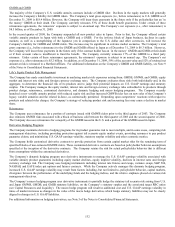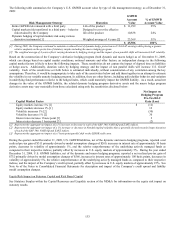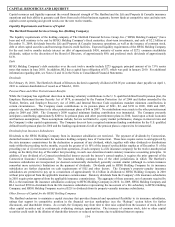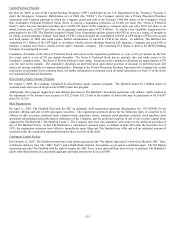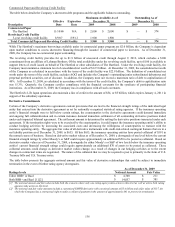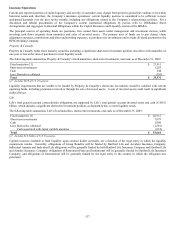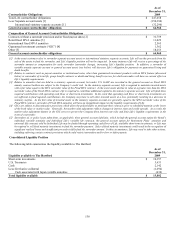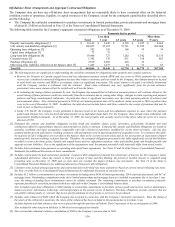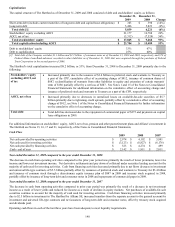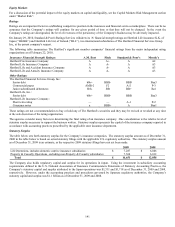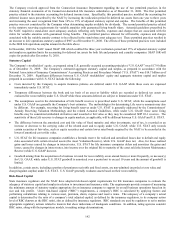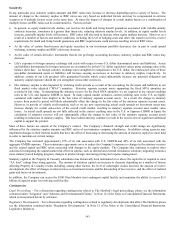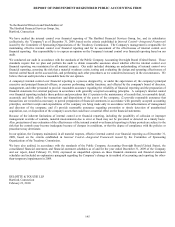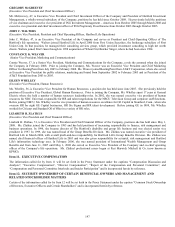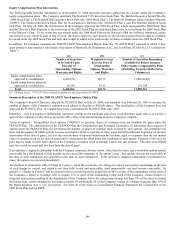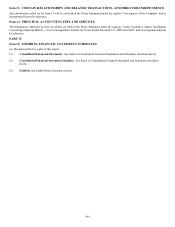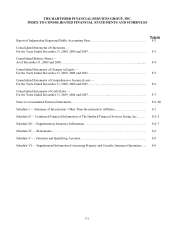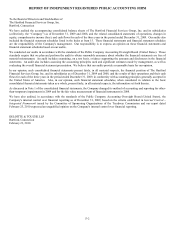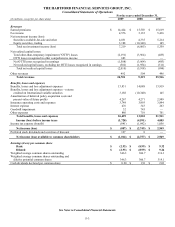The Hartford 2009 Annual Report Download - page 142
Download and view the complete annual report
Please find page 142 of the 2009 The Hartford annual report below. You can navigate through the pages in the report by either clicking on the pages listed below, or by using the keyword search tool below to find specific information within the annual report. 142
The Company received approval from the Connecticut Insurance Department regarding the use of two permitted practices in the
statutory financial statements of its Connecticut-domiciled life insurance subsidiaries as of December 31, 2008. The first permitted
practice related to the statutory accounting for deferred income taxes. Specifically, this permitted practice modified the accounting for
deferred income taxes prescribed by the NAIC by increasing the realization period for deferred tax assets from one year to three years
and increasing the asset recognition limit from 10% to 15% of adjusted statutory capital and surplus. The benefits of this permitted
practice were not considered by the Company when determining surplus available for dividends. The second permitted practice related
to the statutory reserving requirements for variable annuities with guaranteed living benefit riders. Actuarial guidelines prescribed by
the NAIC required a stand-alone asset adequacy analysis reflecting only benefits, expenses and charges that are associated with the
riders for variable annuities with guaranteed living benefits. The permitted practice allowed for all benefits, expenses and charges
associated with the variable annuity contract to be reflected in the stand-alone asset adequacy test. These permitted practices resulted in
an increase to Life operations statutory surplus of $987 as of December 31, 2008. The effects of these permitted practices were included
in the 2008 Life operations surplus amount in the table above.
In December, 2009 the NAIC issued SSAP 10R which codified the three year realization period and 15% of adjusted statutory capital
and surplus recognition limits for accounting for deferred tax assets for both life and property and casualty companies. SSAP 10R will
expire for periods after December 31, 2010.
Statutory Capital
The Company’ s stockholders’ equity, as prepared using U.S. generally accepted accounting principles (“U.S. GAAP”) was $17.9 billion
as of December 31, 2009. The Company’ s estimated aggregate statutory capital and surplus, as prepared in accordance with the
National Association of Insurance Commissioners’ Accounting Practices and Procedures Manual (“U.S. STAT”) was $14.7 billion as of
December 31, 2009. Significant differences between U.S. GAAP stockholders’ equity and aggregate statutory capital and surplus
prepared in accordance with U.S. STAT include the following:
• Costs incurred by the Company to acquire insurance policies are deferred under U.S. GAAP while those costs are expensed
immediately under U.S. STAT.
• Temporary differences between the book and tax basis of an asset or liability which are recorded as deferred tax assets are
evaluated for recoverability under U.S. GAAP while those amounts deferred are subject to limitations under U.S. STAT.
• The assumptions used in the determination of Life benefit reserves is prescribed under U.S. STAT, while the assumptions used
under U.S. GAAP are generally the Company’ s best estimates. The methodologies for determining Life reserve amounts may also
be different. For example, reserving for living benefit reserves under U.S. STAT is generally addressed by the Commissioners’
Annuity Reserving Valuation Methodology and the related Actuarial Guidelines, while under U.S. GAAP, those same living
benefits may be considered embedded derivatives and recorded at fair value or they may be considered SOP 03-1 reserves. The
sensitivity of these Life reserves to changes in equity markets, as applicable, will be different between U.S. GAAP and U.S. STAT.
• The difference between the amortized cost and fair value of fixed maturity and other investments, net of tax, is recorded as an
increase or decrease to the carrying value of the related asset and to equity under U.S. GAAP, while U.S. STAT only records
certain securities at fair value, such as equity securities and certain lower rated bonds required by the NAIC to be recorded at the
lower of amortized cost or fair value.
• U.S. STAT for life insurance companies establishes a formula reserve for realized and unrealized losses due to default and equity
risks associated with certain invested assets (the Asset Valuation Reserve), while U.S. GAAP does not. Also, for those realized
gains and losses caused by changes in interest rates, U.S. STAT for life insurance companies defers and amortizes the gains and
losses, caused by changes in interest rates, into income over the original life to maturity of the asset sold (the Interest Maintenance
Reserve) while U.S. GAAP does not.
• Goodwill arising from the acquisition of a business is tested for recoverability on an annual basis (or more frequently, as necessary)
for U.S. GAAP, while under U.S. STAT goodwill is amortized over a period not to exceed 10 years and the amount of goodwill is
limited.
In addition, certain assets, including a portion of premiums receivable and fixed assets, are non-admitted (recorded at zero value and
charged against surplus) under U.S. STAT. U.S. GAAP generally evaluates assets based on their recoverability.
Risk-Based Capital
State insurance regulators and the NAIC have adopted risk-based capital requirements for life insurance companies to evaluate the
adequacy of statutory capital and surplus in relation to investment and insurance risks. The requirements provide a means of measuring
the minimum amount of statutory surplus appropriate for an insurance company to support its overall business operations based on its
size and risk profile. Under risk-based capital (“RBC”) requirements, a company’ s RBC is calculated by applying factors and
performing calculations relating to various asset, premium, claim, expense and reserve items. The adequacy of a company’ s actual
capital is determined by the ratio of a company’ s total adjusted capital, as defined by the insurance regulators, to its company action
level of RBC (known as the RBC ratio), also as defined by insurance regulators. RBC standards are used by regulators to set in motion
appropriate regulatory actions related to insurers that show indications of inadequate conditions. In addition, rating agencies consider
RBC ratios, along with their proprietary models, in making ratings determinations.


